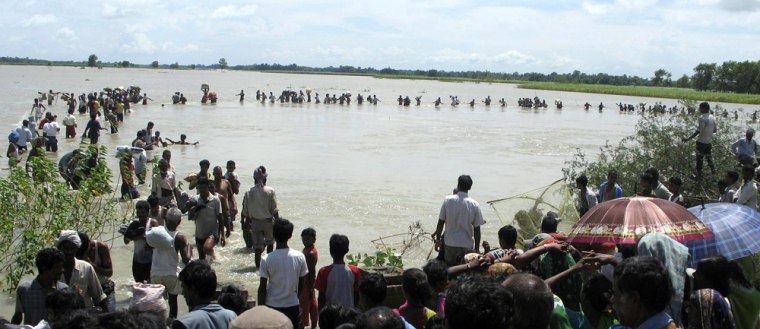Indian officials rushed soldiers and air force helicopters Wednesday to flood-ravaged parts of northern India to provide aid to the more than 1 million people stranded by a surging river.
The death toll from this year's monsoon has already climbed past 800, and now some 1.2 million people have been marooned, and about 2 million more affected in the impoverished state of Bihar, where the Kosi river has burst its banks, breached safety embankments and submerged all roads leading to the region.
Roughly 120 soldiers have joined government aid workers in the area and another 240 are preparing to help, said Prataya Amrit, a senior official at Bihar's disaster ministry.
Four Indian air force helicopters were dropping food and medicine to the stranded, he said.
The state government has set up 300 relief camps to house people evacuated from the flooded areas, Amrit said. He said the rescued people may need to stay in these camps for several months as new embankments are built and the devastated areas regain some semblance of normalcy.
Area cut off
Pictures from the region Tuesday, the first images since last week when flooding cut off the remote area from the rest of India, showed entire villages submerged and women wading through waist-high muddy waters, sacks of belongings balanced on their heads.
Families perched on the roofs of their houses waited for aid while others piled into overloaded canoes.
India's monsoon season, which lasts from June to September, brings rain vital for the country's farmers but also massive destruction. Floods, mudslides, collapsing houses and lightning strikes kill hundreds of people every year.
Despite the rescue operations under way, officials in Bihar have warned that the real danger is still ahead.
When the swollen river burst its banks in Nepal just north of the Indian border, it changed course, flowing through a fresh channel some 75 miles to the east, which has no levees or protective embankments.
And with the river traditionally swelling to a peak and flooding in October, it threatens the area surrounding its new path with destruction.
'Save your lives'
"Save your lives and reach relief camps and other safe places. There is very little time to escape the death and destruction," the state's chief minister Nitish Kumar said in a radio announcement broadcast Tuesday.
Officials said that because people were used to the cycle of the annual floods — temporarily taking shelter and then returning to their lands when the waters recede — they had failed to understand the magnitude of the new threat.
A UNICEF report issued Tuesday said the rains have damaged roads and railway tracks, and water and electricity supplies have been affected.
As hundreds of thousands of people made homeless by the floods reach the relief camps there are fears of infectious diseases as well, the report said.
On Tuesday, police said 22 people had been killed as heavy rains brought several buildings crashing down in the neighboring state of Uttar Pradesh. That state has been the worst hit by this year's monsoon, with more than 800 people killed by flooding since the annual rains began in June, Surendra Srivastava, an Uttar Pradesh police official, told Associated Press.
Despite the dramatic flooding in Bihar, the state has had far fewer deaths than Uttar Pradesh. The state's disaster management ministry said it had reports of 36 people being killed in the flooding and that some 60,000 hectares (150,000 acres) of farm land had been destroyed.
In 2007, monsoon floods killed more than 2,200 people across South Asia and left 31 million others homeless, short of food or with other problems. The United Nations called last year's floods the worst in living memory.
